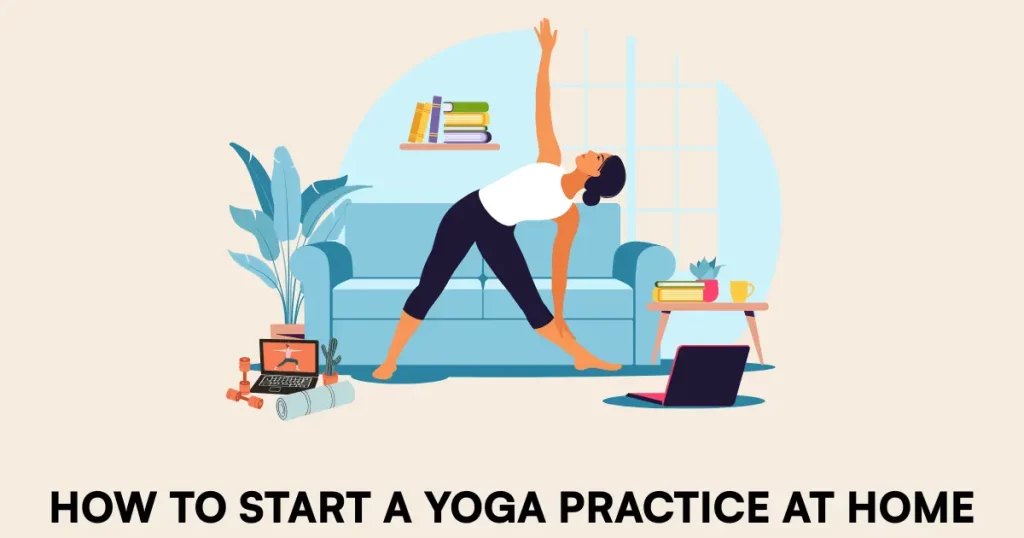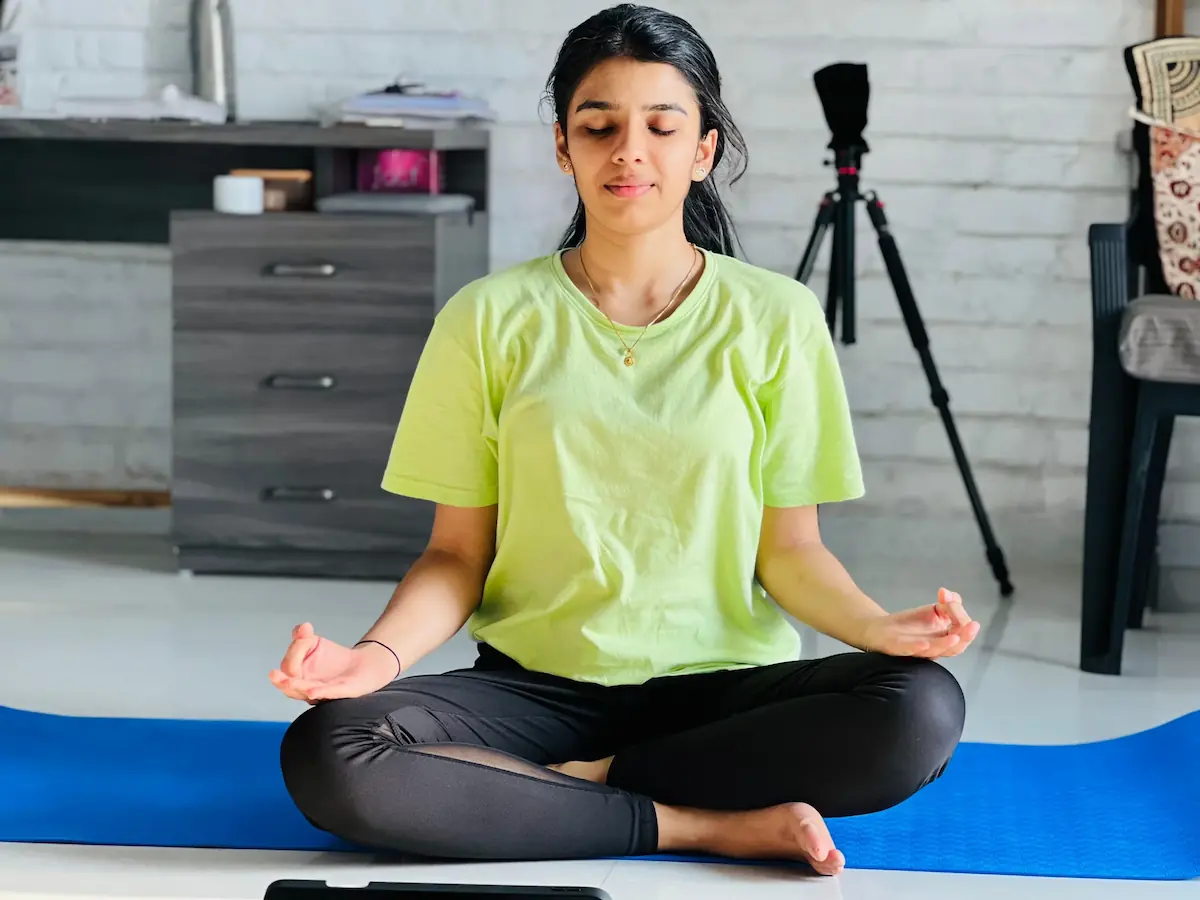Yoga doesn’t need a fancy studio—you can start a life-changing home yoga practice right now. Whether you’re new to yoga or moving from classes to your living room, practicing at home gives you freedom and ease. For example, you pick the time and pace that works for you.
This guide walks you through creating a simple yoga setup, choosing basic equipment, and building an easy yoga routine for beginners. With clear tips and steps, you’ll be doing poses at home in no time—no stress needed!
First, want some beginner poses to try? Check out our Essential Yoga Poses for Beginners. Let’s jump in!
Why Practice Yoga at Home?
A home yoga practice is perfect for beginners. For instance, you decide when to start—morning or night, it’s up to you. You skip poses that feel off and stay longer in ones you like. Plus, there’s no travel or cost—just you and a mat.
A 2021 study in the Journal of Health Psychology even shows home yoga boosts consistency and cuts stress better than occasional studio visits. So, it’s not just easy—it’s effective. Curious about yoga’s bigger picture? See What Is Yoga? to learn its mind-body benefits.

Step 1: Create Your Yoga Space
Your yoga setup is where the magic happens—a calm spot to focus. Here’s how to make it:
- Pick a Spot:
- You need about 6×6 feet—enough to stretch without bumping anything. A living room corner, bedroom, or patio works great.
- Choose a flat floor like wood or tile. Thick carpet? It might make balancing harder. Outside? Keep it level.
- Bonus: A window or plant adds a peaceful touch.
- Cut Distractions:
- Turn off your phone or mute it.
- Tell family, “I’m doing yoga for 20 minutes.”
- Noisy area? Try earbuds or a fan sound to block it out.
- Make It Yours:
- Use soft lights or a lamp—nothing too bright.
- Light a candle (lavender’s nice) or play gentle music like ocean waves.
- Keep it low-key so you can hear your breathing.
- Quick Tips:
- Test it: Stretch out—any obstacles? Move them.
- Clear clutter, like books or toys, for now.
- Add a mirror if you want to watch your form.
Step 2: Choose Your Equipment
You don’t need much for a home yoga practice, but good gear helps. Here’s what to get and why:
- Yoga Mat:
- It protects your knees and stops slips.
- Get one 4–6mm thick—thin hurts, thick wobbles. Look for a grippy one.
- Cheap ones cost $20; nicer ones, like eco-friendly mats, hit $60–$100.
- Test it: Press down—sticky? Wet it—still good? Perfect.
- Extras to Try:
- Blocks: Help you reach the floor or sit comfy. Foam’s light ($8–$12); cork lasts longer ($15–$20). No blocks? Use books.
- Strap: Makes stretches easier, like touching your toes. Get a 6–10-foot one ($5–$15) or use a belt.
- Blanket: Softens knees or relaxes you. Use one from home—free!
- Clothes:
- Wear stretchy stuff—leggings or a tee. Skip loose shirts; they fall in your face.
- Bare feet grip best; cold? Try grippy socks.
- Tech:
- Use a phone for free videos (like “Yoga with Adriene”).
- A small speaker makes music clearer.
- Start Simple: Grab a mat first. Add other stuff later as you go.
🧘 Ready to Take Your Practice Further?
Meditation is a great start—but combining it with movement brings even more balance and clarity. If you’re in Ahmedabad, join us for expert-led yoga and meditation sessions designed to energize your body and calm your mind.
🌟 Book Your First Yoga Class NowStep 3: Build Your Beginner Yoga Routine
A yoga routine for beginners should be easy and fun. Here’s how to make one, step by step:
Set Your Plan
- Time: Start with 15–20 minutes—short but doable.
- When: Morning wakes you up; night calms you down. Try both to see what fits.
- How Often: Aim for 3–4 days a week—enough to stick without tiring you out.
Warm Up (3–5 minutes)
- Cat-Cow Pose: Do 8–10 rounds. Inhale, drop your belly (Cow); exhale, arch up (Cat). It wakes your back.
- Neck Rolls: 5 each way, slow—eases screen stiffness.
- Wrist Circles: 10 each way—gets hands ready.
Main Poses (10–12 minutes)
- Try these from Essential Yoga Poses for Beginners:
- Mountain Pose: Stand tall 1 minute—feel steady.
- Downward Dog: Hold 5–8 breaths—stretch everything. Bend knees if it’s tight.
- Warrior I: 5 breaths each side—strong legs, open chest.
- Tree Pose: 5 breaths each side—balance easy, foot low.
- Child’s Pose: 2 minutes—rest and breathe.
Cool Down (3–5 minutes)
- Seated Stretch: Legs out, reach forward, 5 breaths—use a strap if needed.
- Corpse Pose: Lie flat, relax 3–5 minutes—chill out.
Grow Over Time
- Weeks 1–2: Do this 15-minute flow, 3 times a week.
- Weeks 3–4: Add 5 minutes—maybe a new pose like Thread-the-Needle.
- Later: Try 30 minutes or a video for fun.
- Helpful Tools:
- Apps like “Down Dog” or YouTube’s “Yogaradhna” guide you.
Bonus Tips for Success
- Stick to It: Do yoga after coffee or leave your mat out—it reminds you.
- Listen Up: Sharp pain? Stop. Stretch feeling? Keep going.
- Track It: Write, “Day 1: Wobbly but nice.” See how you improve.
- Learn More: Check out Ultimate Guide to Yoga Basics for extra ideas.
Conclusion
Starting a home yoga practice is simple: a cozy yoga setup, a mat, and an easy yoga routine for beginners. Begin with 15 minutes—feel Mountain Pose ground you, Child’s Pose relax you. It’s not about being perfect; it’s about starting. So, try it today—one breath at a time builds something big.
Want yoga’s story? See What Is Yoga?. How did your first try go? Tell us below!


1 thought on “How to Start a Yoga Practice at Home: A Beginner’s Guide”